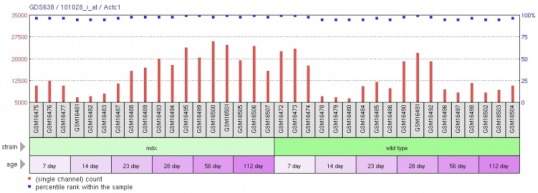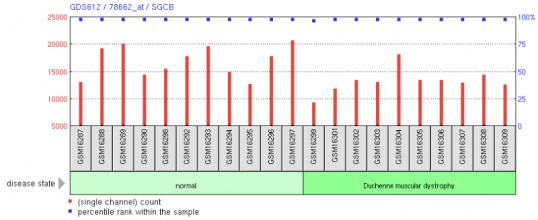DNA MicroArray
DNA MicroArray experiments allow for quantitation of expression of individual genes in different environmental contexts such as tissue type, chemical treatment, or disease state. Gene Expression Omnibus, a database for DNA MicroArray data, was used to find expression patterns in Duchenne Muscular Dystrophy models in mice (denoted "mdx").
Important expression patterns are highlighted below. Due to website restrictions, the images are limited in size. Clicking on each figure will bring up an enhanced version of the image.
Important expression patterns are highlighted below. Due to website restrictions, the images are limited in size. Clicking on each figure will bring up an enhanced version of the image.
The figure above (Porter et al., 2004) shows expression levels of alpha-actin, the primary form of actin in striated muscle fibers, in DMD (left) and wild type (right) mice measured at different life stages. The dmd model mice exhibit dramatic overexpression of alpha-actin as age increases compared to the wild type mice, which exhibit relatively constant, low levels of alpha-actin expression.
The figure above (Haslett et al., 2003) shows expression levels of beta sarcoglycan, a member of the dystrophin-associated complex that connects dystrophyn to the extra cellular matrix, in normal humans (left) and Duchenne Muscular Dystrophy affected humans (right). The change in expression of beta sarcoglycan in DMD individuals compared to non-DMD individuals is less profound that that of alpha-actin. However, there appears to be a distinct down regulation of beta sarcoglycan in DMD individuals compared to wild type. This decrease in expression may contribute to the severity of the DMD phenotype.
References
Porter JD, Merriam AP, Leahy P, Gong B et al. Temporal gene expression profiling of dystrophin-deficient (mdx) mouse diaphragm identifies conserved and muscle group-specific mechanisms in the pathogenesis of muscular dystrophy. Hum Mol Genet 2004 Feb 1;13(3):257-69.
Haslett JN, Sanoudou D, Kho AT, Han M et al. Gene expression profiling of Duchenne muscular dystrophy skeletal muscle. Neurogenetics 2003 Aug;4(4):163-71. PMID: 12698323
Haslett JN, Sanoudou D, Kho AT, Han M et al. Gene expression profiling of Duchenne muscular dystrophy skeletal muscle. Neurogenetics 2003 Aug;4(4):163-71. PMID: 12698323
This site was created by Anthony Parendo for an undergraduate Genetics 677 course at the University of Wisconsin-Madison.



